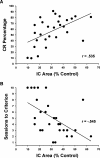Inferior colliculus lesions impair eyeblink conditioning in rats
- PMID: 18086827
- PMCID: PMC2151021
- DOI: 10.1101/lm.716107
Inferior colliculus lesions impair eyeblink conditioning in rats
Abstract
The neural plasticity necessary for acquisition and retention of eyeblink conditioning has been localized to the cerebellum. However, the sources of sensory input to the cerebellum that are necessary for establishing learning-related plasticity have not been identified completely. The inferior colliculus may be a source of sensory input to the cerebellum through its projection to the medial auditory thalamus. The medial auditory thalamus is necessary for eyeblink conditioning in rats and projects to the lateral pontine nuclei, which then project to the cerebellar nuclei and cortex. The current experiment examined the role of the inferior colliculus in auditory eyeblink conditioning. Rats were given bilateral or unilateral (contralateral to the conditioned eye) lesions of the inferior colliculus prior to 10 d of delay eyeblink conditioning with a tone CS. Rats with bilateral or unilateral lesions showed equivalently impaired acquisition. The extent of damage to the contralateral inferior colliculus correlated with several measures of conditioning. The findings indicate that the contralateral inferior colliculus provides auditory input to the cerebellum that is necessary for eyeblink conditioning.
Figures




Similar articles
-
Eyeblink conditioning using cochlear nucleus stimulation as a conditioned stimulus in developing rats.Dev Psychobiol. 2008 Nov;50(7):640-6. doi: 10.1002/dev.20331. Dev Psychobiol. 2008. PMID: 18688803 Free PMC article.
-
Medial auditory thalamus is necessary for acquisition and retention of eyeblink conditioning to cochlear nucleus stimulation.Learn Mem. 2015 Apr 15;22(5):258-66. doi: 10.1101/lm.036947.114. Print 2015 May. Learn Mem. 2015. PMID: 25878138 Free PMC article.
-
Medial auditory thalamic stimulation as a conditioned stimulus for eyeblink conditioning in rats.Learn Mem. 2007 Mar 8;14(3):152-9. doi: 10.1101/lm.465507. Print 2007 Mar. Learn Mem. 2007. PMID: 17351138 Free PMC article.
-
Neural circuitry and plasticity mechanisms underlying delay eyeblink conditioning.Learn Mem. 2011 Oct 3;18(10):666-77. doi: 10.1101/lm.2023011. Print 2011. Learn Mem. 2011. PMID: 21969489 Free PMC article. Review.
-
The ontogeny of associative cerebellar learning.Int Rev Neurobiol. 2014;117:53-72. doi: 10.1016/B978-0-12-420247-4.00004-X. Int Rev Neurobiol. 2014. PMID: 25172629 Review.
Cited by
-
Multiple sites of extinction for a single learned response.J Neurophysiol. 2012 Jan;107(1):226-38. doi: 10.1152/jn.00381.2011. Epub 2011 Sep 21. J Neurophysiol. 2012. PMID: 21940608 Free PMC article.
-
Establishment and transfer of classical eyeblink conditioning using electrical microstimulation of the hippocampus as the conditioned stimulus.PLoS One. 2017 Jun 2;12(6):e0178502. doi: 10.1371/journal.pone.0178502. eCollection 2017. PLoS One. 2017. PMID: 28575003 Free PMC article.
-
Metabolic mapping of rat forebrain and midbrain during delay and trace eyeblink conditioning.Neurobiol Learn Mem. 2009 Oct;92(3):335-44. doi: 10.1016/j.nlm.2009.04.001. Epub 2009 Apr 17. Neurobiol Learn Mem. 2009. PMID: 19376256 Free PMC article.
-
Trigeminal high-frequency stimulation produces short- and long-term modification of reflex blink gain.J Neurophysiol. 2014 Feb;111(4):888-95. doi: 10.1152/jn.00667.2013. Epub 2013 Nov 27. J Neurophysiol. 2014. PMID: 24285868 Free PMC article.
-
Interactions between prefrontal cortex and cerebellum revealed by trace eyelid conditioning.Learn Mem. 2009 Jan 7;16(1):86-95. doi: 10.1101/lm.1178309. Print 2009 Jan. Learn Mem. 2009. PMID: 19144967 Free PMC article.
References
-
- Aitkin L.M., Webster W.R., Veale J.L., Crosby D.C. Inferior colliculus. I. Comparison of response properties of neurons in central, pericentral, and external nuclei of adult cat. J. Neurophysiol. 1975;38:1196–1207. - PubMed
-
- Bao S., Chen L., Thompson R.F. Learning- and cerebellum-dependent neuronal activity in the lateral pontine nucleus. Behav. Neurosci. 2000;114:254–261. - PubMed
Publication types
MeSH terms
Grants and funding
LinkOut - more resources
Full Text Sources
